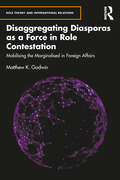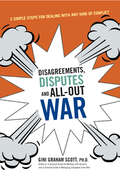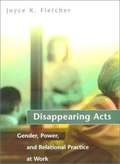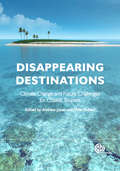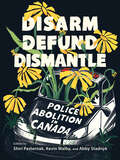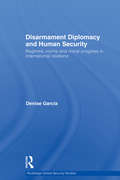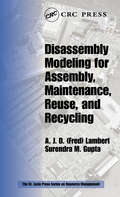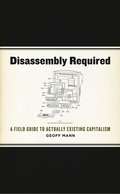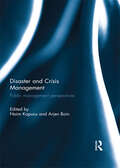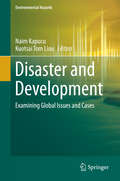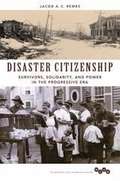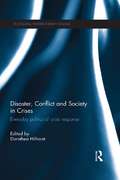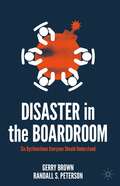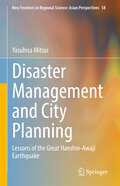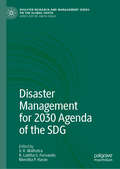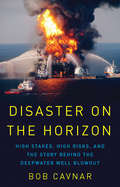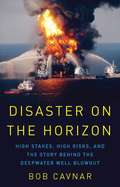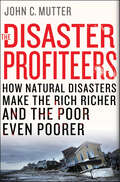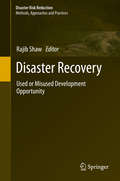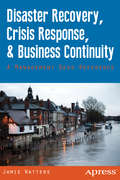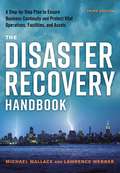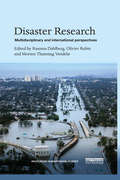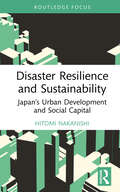- Table View
- List View
Disaggregating Diasporas as a Force in Role Contestation: Mobilising the Marginalised in Foreign Affairs (Role Theory and International Relations)
by Matthew K. GodwinUsing a Role Theory lens, this book investigates Tamil diaspora mass movements and interest groups as marginalised forces of domestic foreign policy influence. Until now Role Theory has not considered diaspora mass movements as collective action actors, nor looked at how marginalised diasporas influence elite foreign policy decision-making. Matthew K. Godwin employs a comparative, micro-level decisionmaking narrative that looks incisively at decisions faced by the British and Canadian governments in 2009 and 2013 towards the Sri Lankan civil war and its aftermath. Through qualitative, elite-level interviews and content analysis of other primary source data, Godwin convincingly argues that when diaspora interest group elites are leveraging the power of mass movements in concert with credible partisan advocates, they can influence role contestation. However, international institutional constraints on role behaviour may stymie their preferred role performance, especially if states are indispensable to the institutions their behaviour may unravel. Ultimately, Godwin concludes that some states can't behave "badly," even when they want to. This book will be of interest to students and researchers oflnternational Relations, Foreign Policy Analysis, Comparative Politics, Migration Studies and to non-government organisations who seek to influence governments.
Disagreements, Disputes, and All-Out War: Three Simple Steps for Dealing with Any Kind of Conflict
by Gini ScottThe potential for conflict exists in every interaction. But when one doesn't know how to deal with these disagreements constructively, they can escalate into unproductive and even destructive situations. The key is not to avoid conflict, but to recognize and manage it skillfully to produce the best possible outcome. In this powerful and practical guide, author Gini Graham Scott shows readers how to identify the reason for the conflict, recognize and control the emotional factors, and find the best solution. Written in an accessible, conversational style, packed with real-life examples, and including simple exercises and tools to help assess conflict situations, this indispensable guide shows readers how to handle whatever life throws at them.
Disappearing Acts: Gender, Power, and Relational Practice at Work
by Joyce K. FletcherChosen as a finalist in the George R. Terry Book Award presented by the Academy of Management for outstanding contribution to the advancement of management knowledge. With its move from hierarchical to team-based structures and its dismantling of functional barriers, the organization of the future is touted as a radical departure from traditional models. The worker of the future, we are told, must be a collaborative team player, able to give and receive help, empower others, and operate in a world of interdependence. This new worker needs relational skills and emotional intelligence--the ability to work effectively with others and understand the emotional context in which work takes place. Paradoxically, the very skills that give organizations a competitive advantage may be precisely those that prevent individual employees--especially women--from advancing. In this book Joyce K. Fletcher presents a study of female design engineers that has profound implications for attempts to change organizational culture. Her research shows that emotional intelligence and relational behavior often "get disappeared" in practice, not because they are ineffective but because they are associated with the feminine or softer side of work. Even when they are in line with stated goals, these behaviors are viewed as inappropriate to the workplace because they collide with powerful, gender-linked images of good workers and successful organizations. Fletcher describes how this collision of gender and power "disappears" the very behavior that organizations say they need and undermines the possibility of radical change. She shows why the "female advantage" does not seem to be advantaging females or organizations. Finally, she suggests ways that individuals and organizations can make visible the invisible work--and people--critical to organizational competence and transformation.
Disappearing Destinations:
by Dr Bas Amelung Dr Giorgio Anfuso Dr Andrew L Jones Dr Michael PhillipsProviding a thorough examination of the threats posed to destinations by tourism, this comprehensive text discusses how popular and fragile destinations such as the Great Barrier Reef could become severely damaged and forced to close to tourists if current tourism trends continue. The consequences of tourism growth, predicted changes, and management and policy responses are reviewed. The book will explore tourism in the context of climate change and vulnerable environments, exploring the situation at local level and in a wider perspective using international case studies throughout and providing future recommendations. It will be an essential text for researchers, policymakers and students in tourism, ecotourism, environmental conservation, planning, coastal management and engineering, climate change and marine conservation.
Disarm, Defund, Dismantle: Police Abolition in Canada
by Shiri Pasternak Kevin Walby Abby StadnykCanadian laws are just, the police uphold the rule of law and treat everyone equally, and without the police, communities would descend into chaos and disorder. These entrenched myths, rooted in settler-colonial logic, work to obscure a hard truth: the police do not keep us safe. This edited collection brings together writing from a range of activists and scholars, whose words are rooted in experience and solidarity with those putting their lives on the line to fight for police abolition in Canada. Together, they imagine a different world—one in which police power is eroded and dissolved forever, one in which it is possible to respond to distress and harm with assistance and care.
Disarmament Diplomacy and Human Security: Regimes, Norms and Moral Progress in International Relations (Routledge Global Security Studies)
by Denise GarciaThis book assesses how progress in disarmament diplomacy in the last decade has improved human security. In doing so, the book looks at three cases of the development of international norms in this arena. First, it traces how new international normative understandings have shaped the evolution of and support for an Arms Trade Treaty (the supply side of the arms trade); and, second, it examines the small arms international regime and examines a multilateral initiative that aims to address the demand side (by the Geneva Declaration); and, third, it examines the evolution of two processes to ban and regulate cluster munitions. The formation of international norms in these areas is a remarkable development, as it means that a domain that was previously thought to be the exclusive purview of states, i.e. how they procure and manage arms, has been penetrated by multiple influences from worldwide civil society. As a result, norms and treaties are being established to address the domain of arms, and states will have more multilateral restriction over their arms and less sovereignty in this domain. This book will be of much interest to students of the arms trade, international security, international law, human security and IR in general. Denise Garcia is Assistant Professor in the Department of Political Science at Northeastern University, Boston. She is author of Small Arms and Security (Routledge 2006).
Disassembling Police Culture (Routledge Frontiers of Criminal Justice)
by Mike RoweDrawing on six years of ethnographic research, this book critically examines police culture, exploring police behaviours, decisionmaking and actions. Police culture is a concept widely used, often critically, to characterise the working attitudes and behaviours of (usually uniformed) police officers. It is shorthand for a workplace imbued with machismo, racism, sexism, a thirst for danger and excitement, cynicism and conservatism. Rather than looking for culture or identifying how culture affects behaviours, this book identifies factors that influence the decisions and actions, including technology, targets, training, timing, intelligence, geography and supervision, thus reassembling police culture much as Bruno Latour sought to reassemble the social. The analysis develops a clearer and critical understanding of culture by explicitly connecting the debates about police culture to those about organisational culture. Offering a detailed ethnography of two shifts, it grounds the analysis of the idea of police culture in a 'thick description' of the day- to- day activities observed in the police station and the patrol car, rather than using brief illustrative extracts. The book dispenses with any assumption of the utility of the concept of police culture, not least because it is opaque, and reassembles our understanding of policing and, if it retains any relevance, of police culture. An accessible and compelling read, this book will appeal to students and scholars of policing, criminology, sociology, law, politics and all those interested in the day- to- day lives of police officers.
Disassembly Modeling for Assembly, Maintenance, Reuse and Recycling (Resource Management)
by A.J.D. (Fred) Lambert Surendra M. GuptaIndustry has grown to recognize the value of disassembly processes across a wide range of products. Increasing legislation that may soon require mandatory recycling of many post-consumed goods and a desire to develop more environmentally benign end-of-life processes has fueled research into this concept. Traditionally, disassembly has been viewed a
Disassembly Required
by Geoff Mann"Geoff Mann is a new breed of monkey-wrencher. He knows that contemporary capitalism has a perverse habit of dismantling itself and gives us a toolkit to build a new, more socially just edifice."-Andy Merrifield, Magical Marxism"Insightful and incisive, thoughtful and thorough, filled with new avenues for thinking about resistence. Pass this one by at your own peril."-Matt Hern, Common Ground in a Liquid CityTo imagine how we might change capitalism, we first need to understand it. To succeed in actually changing it, we need to be able to explain how it works and convince others that change is both possible and necessary. Disassembly Required is an attempt to meet those challenges, and to offer clear, accessible alternatives to the status quo of everyday capitalism.Originally crafted as a comprehensive overview for younger readers, Geoff Mann's explanation of the fundamental features of contemporary capitalism is illustrated with real-world examples?an ideal introduction for anyone wanting to learn more about what capitalism is and where it falls short. What emerges is an anti-capitalist critique that fully understands the complex, dynamic, robust organizational machine of modern economic life, digging deep into the details of capitalist institutions and the relations that justify them to unearth the politically indefensible and ecologically unsustainable premises that underlie them.Geoff Mann teaches political economy and economic geography at Simon Fraser University, where he directs the Centre for Global Political Economy. He is the author of Our Daily Bread: Wages, Workers and the Political Economy of the American West (2007) and a frequent contributor to Historical Materialism and New Left Review.
Disaster and Crisis Management: Public Management Perspectives
by Naim Kapucu and Arjen BoinA wide range of natural hazards pose major risks to the lives and livelihoods of large populations around the world. Man-made disasters caused by technological failures, industrial accidents, spillages, explosions, and fires, compound this threat. Since 9/11, security threats based on violence (terrorism, insurgency, and civil strife) have attracted much governmental attention and a great deal of public resources. As the scale, frequency, and intensity of disasters and crises have dramatically increased over the last decade, the failures in responding to these crises have prompted a critical need to evaluate the way in which the public sector responds to disaster. What have we learned? What has changed in the management of disasters and crises? What do we know about the causes, patterns, and consequences of these events? This book looks at some of the approaches that can be taken to empirically examine disaster and crisis management practices. It contributes to the literature on crisis and disaster management, as well as social policy and planning. Introducing approaches that are applicable to a variety of circumstances in the U.S. and in other countries, it offers ways to think through policy interventions and governance mechanisms that may enhance societal resilience. This book was originally published as a special issue of Public Management Review.
Disaster and Development
by Naim Kapucu Kuotsai Tom LiouThis book offers a systematic, empirical examination of the concepts of disasters and sustainable economic development applied to many cases around the world. It presents comprehensive coverage of the complex and dynamic relationship between disaster and development, making a vital contribution to the literature on disaster management, disaster resilience and sustainable development. The book collects twenty-three chapters, examining theoretical issues and investigating practical cases on policy, governance, and lessons learned in dealing with different types of disasters (e. g. , earthquakes, floods and hurricanes) in twenty countries and communities around the world.
Disaster Citizenship: Survivors, Solidarity, and Power in the Progressive Era
by Jacob A.C. RemesA century ago, governments buoyed by Progressive Era-beliefs began to assume greater responsibility for protecting and rescuing citizens. Yet the aftermath of two disasters in the United States-Canada borderlands--the Salem Fire of 1914 and the Halifax Explosion of 1917--saw working class survivors instead turn to friends, neighbors, coworkers, and family members for succor and aid. Both official and unofficial responses, meanwhile, showed how the United States and Canada were linked by experts, workers, and money. In Disaster Citizenship , Jacob A. C. Remes draws on histories of the Salem and Halifax events to explore the institutions--both formal and informal--that ordinary people relied upon in times of crisis. He explores patterns and traditions of self-help, informal order, and solidarity and details how people adapted these traditions when necessary. Yet, as he shows, these methods--though often quick and effective--remained illegible to reformers. Indeed, soldiers, social workers, and reformers wielding extraordinary emergency powers challenged these grassroots practices to impose progressive "solutions" on what they wrongly imagined to be a fractured social landscape. Innovative and engaging, Disaster Citizenship excavates the forgotten networks of solidarity and obligation in an earlier time while simultaneously suggesting new frameworks in the emerging field of critical disaster studies.
Disaster, Conflict and Society in Crises: Everyday Politics of Crisis Response (Routledge Humanitarian Studies)
by Dorothea HilhorstHumanitarian crises - resulting from conflict, natural disaster or political collapse – are usually perceived as a complete break from normality, spurring special emergency policies and interventions. In reality, there are many continuities and discontinuities between crisis and normality. What does this mean for our understanding of politics, aid, and local institutions during crises? This book examines this question from a sociological perspective. This book provides a qualitative inquiry into the social and political dynamics of local institutional response, international policy and aid interventions in crises caused by conflict or natural disaster. Emphasising the importance of everyday practices, this book qualitatively unravels the social and political working of policies, aid programmes and local institutions. The first part of the book deals with the social life of politics in crisis. Some of the questions raised are: What is the meaning of human security in practice? How do governments and other actors use crises to securitize – and hence depoliticize - their strategies? The second part of the book deals with the question how local institutions fare under and transform in response to crises. Conflicts and disasters are breakpoints of social order, with a considerable degree of chaos and disruption, but they are also marked by processes of continuity and re-ordering, or the creation of new institutions and linkages. This part of the book focuses on institutions varying from inter-ethnic marriage patterns in Sri Lanka to situation of institutional multiplicity in Angola. The final part of the book concerns the social and political realities of different domains of interventions in crisis, including humanitarian aid, peace-building, disaster risk reduction and safety nets to address chronic food crises. This book gives students and researchers in humanitarian studies, disaster studies, conflict and peace studies as well as humanitarian and military practitioners an invaluable wealth of case studies and unique political science analysis of the humanitarian studies field.
Disaster in the Boardroom: Six Dysfunctions Everyone Should Understand
by Gerry Brown Randall S. PetersonWhy when companies come crashing down, do we hear of boards who have failed in their fiduciary duties? Or that they have been ignorant, complacent or downright complicit in these scandals and downfalls? Of course, corporate scandals are nothing new, nor are they limited to any one geography. They are a damning indictment of our systems of corporate governance around the world. And yet, despite this frequency, little or nothing changes. We shrug and move on, accepting they are an unavoidable part of the system that produces incredible wealth for economies and societies. But it should not be that way. Disaster in the Boardroom shows how boards can be better. Looking at why these scandals happen, authors Peterson and Brown present in-depth case studies of major global corporations – including recent contemporary scandals associated with companies such as BP, Facebook and Uber – using the optic of their unique, original and compelling ‘six dysfunctions of the board’ analysis to reveal their particularities but also how they can be overcome. In this book, Brown and Peterson explore common attributes of scandals such as lack of independence from management, missing key voices, cultural amplification, diffusion of responsibility, rule-bound cultures and groupthink. They also identify ways to strengthen boards, improve their culture and competence, and give directors and others the power to take action and ultimately prevent disasters from happening. Disaster in the Boardroom is essential reading for every executive in every boardroom, those aspiring to board positions as well as anyone interested in why boards fail. It has never been more important to pre-identify and eradicate these boardroom dysfunctions – not least so that their impacts upon society can better seen, understood, mitigated, and avoided.
Disaster Management and City Planning: Lessons of the Great Hanshin-Awaji Earthquake (New Frontiers in Regional Science: Asian Perspectives #58)
by Yasuhisa MitsuiThis book first provides a comprehensive guideline for future disaster-resistant city planning in large cities in disaster-prone countries such as Japan. It is a compilation of knowledge and know-how obtained through the author’s work in the national government for one and half years in the Earthquake Reconstruction Headquarters, right after the Great Hanshin-Awaji Earthquake on 17 January 1995. The author has carefully examined the various ad hoc measures taken just after the earthquake, which were criticized because they did not work as well as expected. Additionally, he has examined the later revisions in disaster and risk management systems made at the levels of local and national governments through experience in the Hanshin-Awaji Earthquake, to which the author had long been committed. The author argues that the rescue activities, rehabilitation, and reconstruction plans for disaster countermeasures implemented once a disaster has occurred and the city planning established in ordinary times should be extremely tightly connected with each other. City planning that subsumes rescue activities, rehabilitation, and reconstruction plans against what ought to have happened would critically improve the capability of crisis management and, consequently, protect life and property once a disaster has occurred. Such city planning eventually creates disaster-resistant cities. This book assumes readers to be graduate students who study city planning. It is also beneficial for practitioners and policy makers who are in charge of the construction of disaster-resistant cities at the national and local levels of governments, especially in disaster-prone countries.
Disaster Management for 2030 Agenda of the SDG (Disaster Research and Management Series on the Global South)
by V. K. Malhotra R. Lalitha S. Fernando Nivedita P. HaranThis book shows how specifically each goal of Sustainable Development Goals could be incorporated in country wise developmental programmes set to transform the world. It highlights how a combination of initiatives on mitigation of disasters and a robust progress could build a resilient society. The book discusses multidimensional processes such as administrative, financial and social challenges which can mitigate disasters and help in an advancement towards SDG Goals. It highlights the embeddedness of SDGs in disaster mitigation as they tend to be linked and interdependent. By linking sustainable development to disaster mitigation one gets a strong justification for investment into preparedness as a guarantee or insurance against loss and damages due to unforeseen disasters.
Disaster on the Horizon
by Bob CavnarDisaster on the Horizon is a behind-the-scenes investigative look at the worst oil well accident in US history, which led to the current environmental and economic catastrophe on the Gulf Coast. Cavnar uses his 30 years in the business to take readers inside the disaster, exposing the decisions leading up to the blowout and the immediate aftermath. It will also provide a layman's look at the industry, its technology, people, and risks. It will deconstruct events and decisions made by BP, Transocean, and the US Government before and after the disaster, and the effects of those decisions, both good and bad. Cavnar explains what happened in the Gulf, explores how we arrived at deep water drilling in the first place and then charts a course for how to avoid these disasters in the future.
Disaster on the Horizon: What Happened and Why
by Bob CavnarWhat Really Happened Out in the Gulf? The Deepwater Horizon blowout dominated the world's attention for months, yet Americans still lack an understanding of the greatest environmental disaster in U. S. history. Disaster on the Horizon is the first comprehensive book on the causes of the disaster by expert Bob Cavnar. He delivers a hard-hitting portrait of industry and government woefully unprepared to respond. From inside the oil business - field hand to CEO - Cavnar witnessed the carelessness of the industry first hand when he was burned by a gas well fire in 1981. Disaster on the Horizon reveals explosive details: Collusion between BP and the government to hide the severity of the spill. The blowout preventer technology details - why it failed. The behind-the-scenes story of the Obama administration's $20 billion deal with BP. How BP blamed others for their mistakes. BP's corner cutting on safety. The risky top kill procedure. Obama's failure to take advice from industry experts. Disaster on the Horizon provides a roadmap for ensuring this never happens again. Cavnar calls out his own industry for ignoring safety improvements and lobbying to end the moratorium on off-shore drilling as quickly as possible. Cavnar's takeaways: Technology must be vastly improved before deepwater drilling resumes. The industry had a chance to get started on this during the moratorium, but delayed and lobbied instead. Tougher regulations on deepwater drilling should be enacted in technology, disaster preparedness, and response operations. A comprehensive energy policy that creates a favorable environment for full-scale alternative energy development and conservation.
The Disaster Profiteers: How Natural Disasters Make the Rich Richer and the Poor Even Poorer
by John C. MutterNatural disasters don't matter for the reasons we think they do. They generally don't kill a huge number of people. Most years more people kill themselves than are killed by Nature's tantrums. And using standard measures like Gross Domestic Product (GDP) it is difficult to show that disasters significantly interrupt the economy.It's what happens after the disasters that really matters-when the media has lost interest and the last volunteer has handed out a final blanket, and people are left to repair their lives. What happens is a stark expression of how unjustly unequal our world has become. The elite make out well-whether they belong to an open market capitalist democracy or a closed authoritarian socialist state. In Myanmar-a country ruled by a xenophobic military junta-the generals and their cronies declared areas where rice farms were destroyed by Cyclone Nargis as blighted and simply took the land. In New Orleans the city was re-shaped and gentrified post Katrina, making it almost impossible for many of its poorest, mostly black citizens to return.In The Disaster Profiteers, John Mutter argues that when no one is looking, disasters become a means by which the elite prosper at the expense of the poor. As the specter of increasingly frequent and destructive natural disasters looms in our future, this book will ignite an essential conversation about what we can do now to create a safer, more just world for us all.
Disaster Recovery
by Rajib ShawThis book explains key lessons learned from diverse disaster situations and analyzes them within the framework of governance, education, and technology, providing a framework for disaster recovery as a development opportunity. In post-disaster situations, different types of resources are put into the affected region, varying according to technical, financial, intellectual, and community resources. If properly implemented, disaster recovery can change the context of risk-reduction approaches; if not, it can create additional hazards. In some countries, the post-disaster recovery process has even changed the socio-economic and political context of the affected region and country. The book has 21 chapters and is divided into four parts: governance and institutional issues (five chapters), education and learning issues (four chapters), technology and innovation issues (five chapters), and cross-cutting issues (five chapters). The final chapter provides an analysis of the key topics. The primary target groups for this book are students and researchers in the fields of environment, disaster risk reduction, and climate change studies. The book provides them with a good idea of the current research trends in the field and furnishes basic knowledge about these vital topics. Another target group comprises practitioners and policy makers, who will be able to apply the knowledge collected here to policy and decision making.
Disaster Recovery, Crisis Response, and Business Continuity
by Jamie WattersYou''re in charge of IT, facilities, or core operations for your organization when a hurricane or a fast-moving wildfire hits. What do you do? Simple. You follow your business continuity/disaster recovery plan. If you''ve prepared in advance, your operation or your company can continue to conduct business while competitors stumble and fall. Even if your building goes up in smoke, or the power is out for ten days, or cyber warriors cripple your IT systems, you know you will survive. But only if you have a plan. You don''t have one? Then Disaster Recovery, Crisis Response, and Business Continuity: A Management Desk Reference, which explains the principles of business continuity and disaster recovery in plain English, might be the most important book you''ll read in years. Business continuity is a necessity for all businesses as emerging regulations, best practices, and customer expectations force organizations to develop and put into place business continuity plans, resilience features, incident-management processes, and recovery strategies. In larger organizations, responsibility for business continuity falls to specialist practitioners dedicated to continuity and the related disciplines of crisis management and IT service continuity. In smaller or less mature organizations, it can fall to almost anyone to prepare contingency plans, ensure that the critical infrastructure and systems are protected, and give the organization the greatest chance to survive events that can--and do--bankrupt businesses. A practical how-to guide, this book explains exactly what you need to do to set up and run a successful business continuity program. Written by an experienced consultant with 25 years industry experience in disaster recovery and business continuity, it contains tools and techniques to make business continuity, crisis management, and IT service continuity much easier. If you need to prepare plans and test and maintain them, then this book is written for you. You will learn: How to complete a business impact assessment. How to write plans that are easy to implement in a disaster. How to test so that you know your plans will work. How to make sure that your suppliers won''t fail you in a disaster. How to meet customer, audit, and regulatory expectations. Disaster Recovery, Crisis Response, and Business Continuity: A Management Desk Reference will provide the tools, techniques, and templates that will make your life easier, give you peace of mind, and turn you into a local hero when disaster strikes. What you''ll learn All the concepts comprising business continuity, IT service continuity, data recovery, and crisis management How to set up and run an end-to-end business continuity program for your organization How to write business continuity policies and governance documents How to test your business continuity plans, system DR, data center DR, and crisis management processes How to avoid almost all the common traps that both beginners and experienced practitioners fall into How to keep your IT system up and running in the face of disaster Who this book is for Business continuity managers and analysts, emergency planners, disaster recovery managers, service continuity managers and analysts, IT project and operations managers, IT availability managers, auditors, facilities managers, heads of IT, risk analysts and managers, site managers, office managers, governance professionals, and C-level managers. Table of Contents Introduction Part One: Introduction to Business Continuity and Disaster Recovery 1. An Overview of Business Continuity Management (BCM) 2. Essentials of BCM Part Two: Plan for Business Continuity and Disaster Recovery 3. Get Started on Your Plan: First Things First 4. Prepare the Plan 5. Write a IT Disaster Recovery Plan 6. Write a Business Process Recovery Plan 7. Manage Supply Chain Continuity 8. Select and Manage Continuity Suppliers 9. Educate the Workforce 10. Provide Governance and Reporting Part Three: Test and Maintain Your Continuity and Recovery Plans 11. Testi...
The Disaster Recovery Handbook: A Step-by-Step Plan to Ensure Business Continuity and Protect Vital Operations, Facilities, and Assets
by Michael Wallace Lawrence WebberExpect the best. Plan for the worst.Survey the headlines: superstorms, data breaches, pandemics, system failures, and strikes occur regularly...somewhere. If a disaster hits your organization — will you be prepared? With the detailed guidance found in The Disaster Recovery Handbook, your company’s survival and the speedy resumption of business is assured.This thoroughly updated third edition provides readers with clear and comprehensive instructions for assessing risk; documenting recovery procedures; assembling a disaster team; testing and debugging every step; protecting material resources; and safeguarding vital records.Featuring an examination of emerging risks, developments in IT networking, and an all-new chapter on information security, this all-in-one tool kit helps you both avoid potential trouble and recover swiftly when the worst occurs.Anything can happen, but The Disaster Recovery Handbook helps you plan for every contingency, ensuring your company is responsible, ready, and resilient.
The Disaster Recovery Handbook: A Step-by-Step Plan to Ensure Business Continuity and Protect Vital Operations, Facilities, and Assets
by Michael Wallace Lawrence WebberTerrorist attacks. Data assaults. Natural catastrophes. Disease outbreaks. Recent years have taught us that not only was 9/11 not just a single, horrible occurrence, but that events of many types canùand statistically willùhit organizations of every size, threatening to disrupt and potentially even destroy those that are not fully prepared. This revised edition, filled with up-to-the-minute thinking and the latest legal and technological updates, provides readers with practical tools and ready-to-use instructions for assessing risk; clearly documenting recovery procedures; assembling a disaster team; testing and debugging every step; protecting material resources; and recovering vital records. In addition to a CD packed with forms and checklists, the book contains case studies, interviews, and all the practical guidance needed to create the kind of thorough disaster recovery plan every responsible organization must have in place.
Disaster Research: Multidisciplinary and International Perspectives (Routledge Humanitarian Studies)
by Olivier Rubin Rasmus Dahlberg Morten Thanning VendeløGiven the tendency of books on disasters to predominantly focus on strong geophysical or descriptive perspectives and in-depth accounts of particular catastrophes, Disaster Research provides a much-needed multidisciplinary perspective of the area. This book is is structured thematically around key approaches to disaster research from a range of different, but often complementary academic disciplines. Each chapter presents distinct approaches to disaster research that is anchored in a particular discipline; ranging from the law of disasters and disaster historiography to disaster politics and anthropology of disaster. The methodological and theoretical contributions underlining a specific approach to disasters are discussed and illustrative empirical cases are examined that support and further inform the proposed approach to disaster research. The book thus provides unique insights into fourteen state-of-the-art disciplinary approaches to the understanding of disasters. The theoretical discussions as well as the diverse range of disaster cases should be of interest to both postgraduate and undergraduate students, as well as academics, researchers and policymakers.
Disaster Resilience and Sustainability: Japan’s Urban Development and Social Capital (Routledge Research in Sustainable Planning and Development in Asia)
by Hitomi NakanishiThis book examines urban planning and infrastructure development in Japanese cities after the second world war as a way to mitigate the risks of disasters while pursuing sustainable development. It looks at the benefits of social capital and how communities organise to tackle problems during the recovery phase after a disaster. The book also illustrates with case studies to highlight community attitudes which improve recovery outcomes. The book underlines challenges such as ageing and depopulation which Japan would face should the next disaster occur. These demographic shifts are causing difficulties among neighbourhood associations at a time when communities need to effectively support each other. Nakanishi explains why overcoming these societal issues is imperative for sustainability and the need for a comprehensive approach which would integrate smart technology. This book will be of interest to scholars in city development and planning, urban studies and human geography, as well as those interested in building resilient communities.
